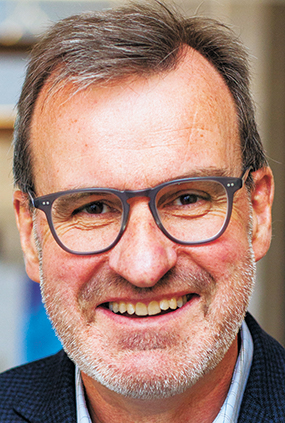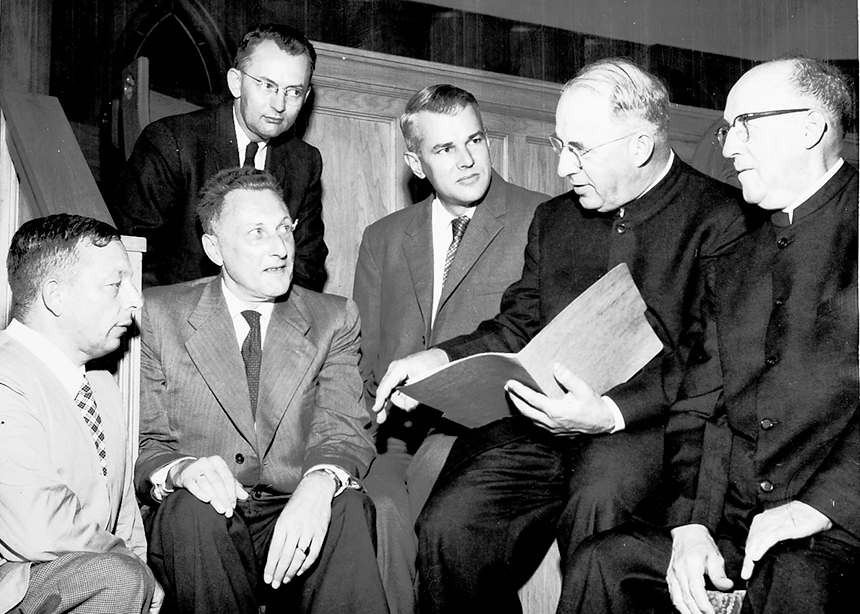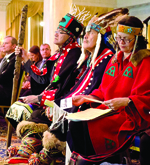As a minister of the Mennonite church in Danzig (now Gdansk, Poland), Hermann Gottlieb Mannhardt knew how to challenge and encourage his congregants in matters of faith and moral conduct. He also knew how to energize a crowd in matters related to politics and patriotism.
During the First World War, as Germany’s armed forces were unleashing a path of destruction across Europe, Mannhardt made his way to the Danzig Hotel to give a rousing address to his fellow citizens in support of his nation’s war efforts. He urged his listeners to remember earlier struggles for liberty and nationhood, reminding his audience that long ago Germanic tribes had defeated Roman armies in the Teutoburg Forest. Drawing on the literary sources of poets and songwriters associated with the 19th-century German wars of liberation, he waxed eloquently about Germany’s exceptional place in the world. Then, with a battle cry urging ultimate sacrifice, he called on men and women to bleed and die as heroes for the sake of the German nation.
Mannhardt’s speech may shock us, especially if we are accustomed to thinking of Mennonites as a people opposed to war. Together with other religious communities, such as the Church of the Brethren and the Quakers, Mennonites typically have been associated with the historic peace churches. And yet it seems that there may be another side to the Mennonite story that may call some of this thinking into question.
Indeed, the 500-year Mennonite story is multi-faceted and not without blemish. Some 16th-century Anabaptists, for example, were pacifists, but there were many who identified with—and even participated in—the peasant uprisings in the environs of present-day Switzerland, South Germany and Austria. There were also revolutionary and sometimes violent expressions of Anabaptism in the northern cities of Amsterdam, Delft and Münster.
Following these tumultuous years, Mennonites were hardly the “quiet in the land.” In the 17th century, some Dutch Mennonites armed their ships with cannons. A century later, they were involved in the militant Dutch Patriot Movement, bent on overthrowing the monarchy. A few years later, Swiss and Prussian Mennonites fought in the Napoleonic wars. In the early 20th century, some Mennonites joined self-defence units to protect Russian Mennonite villages from roving anarchists. And during both World Wars, some Mennonites from both sides of the Atlantic fought on the battlefields of Europe, and some even collaborated with the Nazis in carrying out atrocities against Jews.
Retouching a negative portrait of Anabaptism
To be sure, there has always been a nonresistant or pacifist thread running through the Mennonite story. Throughout the centuries, one can find countless examples of strong opposition to warfare. Mennonite confessional statements have almost, without exception, maintained principles of nonresistance or pacifism. Yet Mennonite lived-experience has not always mirrored churchly ideals, and sometimes Mennonites have behaved in ways that many modern-day observers would find abhorrent. When brought to the surface, these details can be troubling and can lead to questions about Mennonite identity and the way in which the Mennonite story has been told.
For hundreds of years, Catholics and Protestants painted a negative portrait of Anabaptism. History books described adherents of the tradition as fanatical, sectarian, and even dangerous. In the middle of the 20th century, however, the portrait was revised, thanks to revisionist historians who rallied to set forth a counter-narrative, focussing on Anabaptist exceptionalism. In describing the early Anabaptists as heroes, a generation of scholarship was successful in rehabilitating the story.
A central figure who was responsible for this revisioning was Harold S. Bender, a widely respected Mennonite leader from Goshen, Ind., who wrote a highly influential essay called “The Anabaptist Vision.” His essay focussed on the beginning of the Swiss Anabaptist movement and highlighted the extent to which early Anabaptists managed to live out the gospel while emphasizing discipleship, community and the practice of nonresistance.
This revised account was enormously helpful for European Mennonites who were trying to make sense of the devastation in the aftermath of the Second World War. In North America, the revisionist theme likewise provided an inspiring road map as Mennonites in the United States and Canada were migrating to the cities and seeking direction while running up against fundamentalist, evangelical and liberal-Protestant alternatives.
This revising of the Anabaptist story also came at a critical juncture after the war years, as Mennonites in North America were energetically building institutions such as camps, schools, mission and relief agencies and financial organizations. The emphasis on discipleship, community and peace set a welcoming tone for a generation of builders and leaders who needed a vision for their various endeavours.
A multi-faceted emerging portrait
Yet such revisionist story-telling would fall on hard times. While it would continue to resonate in church circles, it would not survive in the academy. Beginning in the 1970s, European and North American historians, less worried about defending denominational ideologies, began poking holes through what obviously had become an unsustainable narrative. In the following decades, the edifice holding up this ideal vision would crumble.
Most scholars today describe an Anabaptism of many stripes and characteristics, a portrait that includes examples of discipleship, community and peace, but also instances that look much different. Sometimes the images are more mystical, sometimes more worldly, sometimes more violent and always more complex.
The emerging portrait underscores the extent to which Anabaptist ideas were never particularly original. Scholars note the way in which Anabaptist ideas and practices were clearly shaped by social and political movements, and the way in which Anabaptist spirituality was thoroughly influenced by Catholic and Protestant realities.
Rather than a pristine “naked Anabaptism,” with thick boundaries maintaining religious purity, scholars now observe a great deal of hybridity between the Anabaptists and their surrounding environs. The boundary lines between Anabaptism and the so-called outside world are seen to be exceedingly porous, with impulses moving across the lines in both directions.
Complex, dynamic and ‘worldly’ origins
Another important and perhaps more profound development in the scholarship has been the interest in looking at the longer history that appears to be every bit as dynamic as the story about beginnings. Beyond the 16th century, the curious observer encounters an evolving movement, reflecting an ever-growing and wide-ranging spiritual expression. Clearly, the unhinging of historical writing from narrowly constructed confessional narratives has opened the door to a Mennonite world that is complex, dynamic and “worldly.” Such encounter with the past is more truthful and can often be inspiring. But honest scrutiny of the historical details will lead to disagreeable specifics as well. What are we to make of those unsavoury details in the Mennonite story?
A good dose of historical perspective is important. It may be easy for us, for example, to disavow and distance ourselves from Hermann Mannhardt’s strident address that he gave at the Danzig Hotel. We have the benefit of hindsight and can observe the lines that connect his speech not only to the atrocities of the First World War but also to the hyper-nationalism and anti-Semitism of Hitler’s Third Reich.
Mannhardt, however, did not have the benefit of our 21st-century perspective. He was limited by the horizons of his day and not immune to the influences and assumptions that shaped early 20th-century German society. In his time, the pressure to proclaim “Germany first” was real. For more than a hundred years, the Prussian government had exerted massive pressure on minority groups, such as the Mennonites, to embrace nationalism and to champion values of racial superiority and German exceptionalism. It would have been truly extraordinary for someone like Mannhardt to have opposed the reigning values of his day.
We could point a finger at Mannhardt’s ignorance, but perhaps a better strategy would be to use his story to reflect on our own vulnerabilities. Were we to live in his world, would we have acted differently? In our own time, are we truly immune to destructive forms of nationalism? What are the blinders that may be obscuring our current vision?
In the context of church life and in conversation with others, it is important that Mennonites not idealize their story. To be sure, there are heroic stories to tell. When narrated well, such stories have the capacity to inspire and empower. But we also need to tell other stories—even those that cast dark shadows. Such telling will be an act of truthfulness, and along the way we may have an opportunity to learn something about human nature and ourselves.
An earlier version of this essay appeared with the title, “On judging the past,” in Mennonite Historian, 42, No. 3 (September 2016), pages 2, 4-5, 10. For more information regarding Hermann Mannhardt’s speech, see “German nationalism and the First World War: Hermann G. Mannhardt’s heroic deeds and heroes,” by Walter Klaassen, Harry Loewen and James Urry, published in Mennonite Quarterly Review, 88, No. 4 (October 2014): pages 517-536.
Karl Koop is professor of history and theology at Canadian Mennonite University in Winnipeg.
For discussion
1. Do you have stories about “black sheep” in your family or congregational history? Do you find these stories stimulating or disheartening? What motivates us to tell or suppress negative stories from the past? Why might it be important to air at least some of these “unsavoury details?”
2. Karl Koop describes how Harold S. Bender’s “Anabaptist Vision” led to a revision of Mennonite history. How did Bender’s emphasis on discipleship, community and peace change the Mennonite church? Why do we keep revising history?
3. Do you think traditionalist Mennonites have been able to keep their self-identity from changing? How do they try to avoid being influenced by Canadian culture?
4. Koop says that “Mennonite lived-experience has not always mirrored churchly ideals, and sometimes Mennonites have behaved in ways that many modern-day observers would find abhorrent.” What are some of his examples? Can you think of other examples of people not living up to ideals? How do you deal with these “unsavoury details”?
5. Just as H.G. Mannhardt accepted and proclaimed the idea of German nationalism more than a century ago, what are some ways of thinking that we absorb from Canadian culture today? Why is it important to monitor the influence that culture has on our thinking?
—By Barb Draper










Leave a Reply
You must be logged in to post a comment.